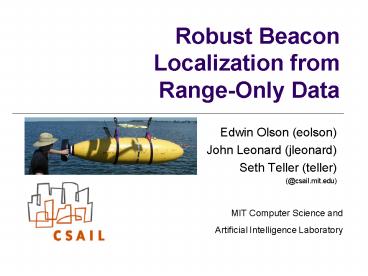Robust Beacon Localization from Range-Only Data - PowerPoint PPT Presentation
Title:
Robust Beacon Localization from Range-Only Data
Description:
Nasty, consistent-looking outliers. There's no signal at all here... Path with no priors (this work) Note accuracy up to global translation/rotation ... – PowerPoint PPT presentation
Number of Views:27
Avg rating:3.0/5.0
Title: Robust Beacon Localization from Range-Only Data
1
Robust Beacon Localization from Range-Only Data
- Edwin Olson (eolson)
- John Leonard (jleonard)
- Seth Teller (teller)
- (_at_csail.mit.edu)
MIT Computer Science and Artificial Intelligence
Laboratory
2
Outline
- Our goal
- Navigate with LBL beacons, without knowing the
beacon locations - Filtering range data without a prior
- Outlier rejection with very noisy data
- SLAM with estimated beacon locations
- Optimal exploration
3
Problem Statement
- Simultaneous Localization and Mapping (SLAM)
- Range-only measurements
- Features only partially observable
- Use vehicles dead reckoning to bootstrap
solution - Applications
- Covert mine sweeping (beacons not calibrated)
- Detecting movement of a stationary beacon
- SLAM with uncalibrated sensor networks.
4
Basic Idea
- Record range measurements while traveling a
relatively short distance. - Initialize feature in Kalman filter based on
triangulation. - Continue updating both robot state and beacon
position with EKF. - but
5
Feature Initialization
- This is the hard step.
- Noise is major issue
- No prior with which to do outlier detection!
- The noise is not well behaved
6
Noise is not Gaussian
- Easy solution (LSQ) if range error is Gaussian.
- Its not.
These extreme outliers will cause trouble in any
linear filter
Distribution of LBL error (relative to true
range). Best Gaussian fit in red. (GOATS02 data)
7
Noise is not independent or stationary
Nasty, consistent-looking outliers
Theres no signal at all here but there is
dependent noise.
8
Median Windows (baseline algorithm)
- Method
- Compute distribution of data z(t) around time t
- Outlier if z(t)ltlowPercentile or
z(t)gthighPercentile - Pros
- Simple, Fast
- Cons
- Cant distinguish stationary garbage from a real
signal - Three sensitive parameters to tune
- Cannot take advantage of multiple observations
from different AUVs.
9
Median Windows
Median window misclassifies inliers
- Hard to tune!
- Data dependent
- Inevitably throwing away good data in order to
avoid outliers
10
Improving Outlier Rejection
- Add geometrical constraints
- Require measurements to intersect
- In AUVs, we dont get much data
- Extract everything we can out of what we have
- We can afford to do more processing not CPU
limited.
11
Measurement Consistency
- Consider pair-wise measurement consistency
- Imposes geometrical constraint on accepted points
- How do we turn pair-wise constraints into a
global classifier?
12
Spectral Clustering Formulation
- Consider Markov process
- Every measurement is a single state
- Define transition matrix P
- Consistent states have high probability
transitions - Find the steady-state state probability vector S.
- (what state will we be in as t?8 ?)
- t0 S t1 PS t2 P2S tn PnS
- Best S is eigenvector of P with largest
eigenvalue - (smaller eigenvalue components get smaller and
smaller as t?8)
13
Spectral Clustering
- Use singular value decomposition (SVD)
- USVTP
- First column of U is solution to PS?S with
maximum ?. - Cluster based on thresholding U(,1) by
mean(U(,1)).
14
Computation in blocks
- Compute SVD for small sets of measurements
- Manages computational cost O(n3)
- Avoids errors in transition matrix by bounding
accumulated DR error - Becomes effective at N10 for typical LBL data
- Performance very good at N25
15
Spectral Clustering
- Each circle is a range measurement centered about
the AUVs dead-reckoned position - Blue circles are inliers
- Black circles are outliers
- Green triangle represent actual LBL position
Spectral clustering of 25 measurements (GOATS02
data)
16
Spectral Clustering Result
Median Window (N21, 20, 80)
Spectral Clustering, block size25
17
Multiple vehicles
- If vehicles positions are known in the same
coordinate frame, just add the data and use the
same algorithm. - No need to do outlier rejection independently on
each AUV. - (More on this for AUV2004)
18
Effect of outlier rejection
- PDF after outlier rejection
- Can we restore our Gaussian assumptions?
- Maybe not quite
- But were much better!
Distribution of LBL error (relative to true
range). Outliers rejected via Spectral
Clustering. Best Gaussian fit in red. (GOATS02
data)
19
Solution Estimation
- Given clean data, estimate a beacon location
- Or determine that its still ambiguous
- K-means clustering of range intersections
- Typically K2
- We get a measure of cluster variance (confidence)
- Least-squares solution within selected cluster
20
Solution Estimation
- Put each intersection into a 2-dimensional
accumulator - Extract peaks
- We get multiple solutions and the number of votes
for each - Initialize feature at mean of points in bucket
21
SLAM
- Path with no priors (this work)
- Note accuracy up to global translation/rotation
- Error accumulated while locking
- Dead-reckoned path in Red
- EKF path with prior beacon locations in magenta
22
SLAM Movie
23
Optimal Exploration
- Robot at x, beacon is at either A or B.
- Disambiguate by maximizing the difference in
range depending on actual location - i.e., maximize
- What should robot do now?
Path leads to two possible solutions
Path leads to only one plausible solution
24
Optimal Exploration Solution
- Gradient is easily computed
- Absolute value handled by setting A to be the
closest of A and B.
Optimal robot motions given possible beacon
locations at (-1,0) and (1,0). Arrow size
indicates magnitude of ?r per distance traveled.
25
Future Work
- Guess beacon locations earlier and use particle
filter to track the multiple hypotheses - Incorporate optimal exploration algorithm into
experiment.
26
Questions/Comments
- How can I make this better/more compelling for
the conference?































